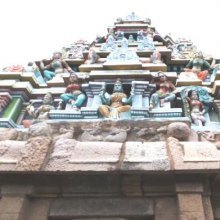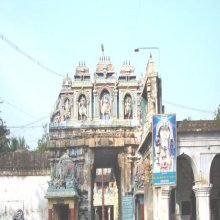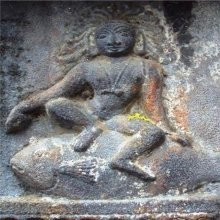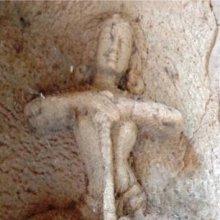Gopura, Go-pura: 20 definitions
Introduction:
Gopura means something in Hinduism, Sanskrit, Buddhism, Pali, the history of ancient India, Marathi. If you want to know the exact meaning, history, etymology or English translation of this term then check out the descriptions on this page. Add your comment or reference to a book if you want to contribute to this summary article.
Images (photo gallery)
(+8 more images available)
In Hinduism
Vastushastra (architecture)
Source: Wisdom Library: Vāstu-śāstra1) Gopura (महाद्वार) refers to the “tower” built above the main entrance (mahādvāra) of the prākāras (‘enclosure’) of the temple complex. There are five kinds of gopuras defined:
- dvāraśobha,
- dvāraśāla,
- dvāraprāsāda,
- dvāraharmya,
- dvāragopura.
To match the seven types of prākāras (‘enclosure’), the following are added as per tradition:
- dvāramaryāda,
- mahāmaryāda.
2) Gopura also refers to a tower build above the gateways of houses, palaces and Buddhist monasteries. There are various types of gopuras defined:
- śrīkara,
- ratikānta,
- kāntavijaya,
- vijayaśālaka,
- viśālālaya,
- vipratīkānta,
- śrīkānta,
- caturmukha,
- keśaviśālaka,
- svastika,
- dvisvastika,
- mardala,
- mārtāṇḍa,
- śrīviśāla,
- śrīkeśa.
Gopura (गोपुर) is a tower built above the mahādvāra of the temple. This term is also applied to the towers built above the gateways of the houses, palaces and Buddhist monasteries. The method of construction of the gopura is almost similar to the construction of the main shrine of the temple. Here also, from foundation to the entablature, the method followed is one and the same. Gopura, in almost all cases, is provided with an upapīṭha. Occasionally double upapīṭha is also provided.
The Texts classify the gopuras into three categories i.e. adhama, madhyama and uttama based on the number of talas built above the mahādvāra. Texts prescribe that the shape of the coping of the gopura should be of sabhākāra i.e. rectangular on plan and the coping is of śāla type. Texts also prescribe that they can be provided with gavākṣas and jālakas.
Gopura in Sanskrit means a “town-gate”. The etymology of the term gopura is obscure. The word obviously presents a sense connected to ‘go’ i.e. cow. It is possible that all the towers of south Indian temples possess, at the two ends of their coping, a pair of semi circular cresting in the form of a cows horn. It is possible that due to this ornamental member, the name gopura is given for this structure.
Source: Knowledge Traditions & Practices of India: Architecture (1): Early and Classical ArchitectureGopura (गोपुर) refers to an “elaborate gateway”, a common concept found in the ancient Indian “science of architecture” (vāstuvidyā).—Gopura is an elaborate gateway, especially in south Indian temples, generally in the
form of a tower.

Vastushastra (वास्तुशास्त्र, vāstuśāstra) refers to the ancient Indian science (shastra) of architecture (vastu), dealing with topics such architecture, sculpture, town-building, fort building and various other constructions. Vastu also deals with the philosophy of the architectural relation with the cosmic universe.
Shaivism (Shaiva philosophy)
Source: DSpace at Pondicherry: Siddha Cult in Tamilnadu (shaivism)Gopura (गोपुर).—The gopura is principally a development of the 11th century middle-Colā period of temple construction in Tamilnādu. After a long gap of hundred years, the Vijayanagara architects revived the gopura structures as well as they made it a pan-south Indian feature of temple architecture, spreading across the whole of Tamilnādu and much of Āndhra Pradesh and Karnātaka, in which most of the Tāntric images portraying the tāntric rites, images of Nātha-siddhas are sculpted in different styles and forms, either in stucco in the upper part of the gopura or in the granite in the lower parts of the gopura.

Shaiva (शैव, śaiva) or Shaivism (śaivism) represents a tradition of Hinduism worshiping Shiva as the supreme being. Closely related to Shaktism, Shaiva literature includes a range of scriptures, including Tantras, while the root of this tradition may be traced back to the ancient Vedas.
Shaktism (Shakta philosophy)
Source: Google Books: Manthanabhairavatantram1) Gopura (गोपुर) is the name of a saṃdoha (meeting place) [or upasaṃdoha—secondary meeting place?), according to the Śrīmatottara-tantra verse 3.135-138, an expansion of the Kubjikāmatatantra: the earliest popular and most authoritative Tantra of the Kubjikā cult.—The first saṃdoha of the Yoginīs was emanated near to Śrīgiri and the second near the town of Ujjayinī. The others are Trikūṭa, Tripura, Gopura, Bhadrakarṇa ([Manuscript] Kh: Bhadrakaṣṭa; [Manuscript] G: Bhadrakīrṇa), Kirāta, the region of Kaśmīra, Sauvala (kh: Sauvara, g: Śaivāla) and Sindhudeśa.
2) Gopura (गोपुर) refers to “archways”, according to the Ṣaṭsāhasrasaṃhitā, an expansion of the Kubjikāmatatantra: the earliest popular and most authoritative Tantra of the Kubjikā cult.—Accordingly, “(Jālandhara) is in the southern corner of (Kailāśa). It shines (like) the moon and has the moon’s radiant lustre. Its form is that of the city of the Half Moon. It has deep lakes and rivers full of waves. It contains the ocean of the six planes, and is fearsome (with the many great) waves that wash against its shores. That city of the Supreme Lord is on top of the lord of the principles. It is adorned with snow (white) moonstones and varied enclosing walls, archways [i.e., gopura], and palaces (aṭṭāla). It possesses many qualities and wonders. [...]”.

Shakta (शाक्त, śākta) or Shaktism (śāktism) represents a tradition of Hinduism where the Goddess (Devi) is revered and worshipped. Shakta literature includes a range of scriptures, including various Agamas and Tantras, although its roots may be traced back to the Vedas.
India history and geography
Source: Cologne Digital Sanskrit Dictionaries: Indian Epigraphical GlossaryGopura.—(EI 3, 19, 24) a gateway; the gateway of a temple; a tower. Note: gopura is defined in the “Indian epigraphical glossary” as it can be found on ancient inscriptions commonly written in Sanskrit, Prakrit or Dravidian languages.
Source: Heidelberg: Glory of the Tiruvanantapuram Padmanabhasvami TempleGopura (गोपुर) refers to the “towers at the entrances” of Hindu temples, according to the Syānandūrapuravarṇana-prabandha by Svāti-Tirunāḷ (1813-1846) (one of the rulers of Travancore) which deals with the different activities of the Thiruvananthapuram Temple, including ceremonies and festivals.—[...] The fifth chapter also gives a detailed sketch of the temple and its components, such as the balipīṭha (pedestal for food offerings) (5.8), various maṇḍapas (pillared halls) (5.9–10), vimānas (towers on top of the sanctum) (5.10), the single stone maṇḍapa (5.11), the dhvajastambha (flag-post) (5.12–14), the gopura (towers at the entrances) (5.14–15), the kulaśekharamaṇḍapa (5.15), etc.

The history of India traces the identification of countries, villages, towns and other regions of India, as well as mythology, zoology, royal dynasties, rulers, tribes, local festivities and traditions and regional languages. Ancient India enjoyed religious freedom and encourages the path of Dharma, a concept common to Buddhism, Hinduism, and Jainism.
Languages of India and abroad
Pali-English dictionary
Source: BuddhaSasana: Concise Pali-English Dictionarygopura : (nt.) gateway; gate tower.

Pali is the language of the Tipiṭaka, which is the sacred canon of Theravāda Buddhism and contains much of the Buddha’s speech. Closeley related to Sanskrit, both languages are used interchangeably between religions.
Marathi-English dictionary
Source: DDSA: The Molesworth Marathi and English Dictionarygōpura (गोपुर).—m n (S) The building over the gate (of a city, of the encircling wall of a temple, palace &c.) 2 A gate so overbuilt. 3 A gate gen. 4 The figures drawn by women on the walls in the month caitra. 5 A grass, Cyperus rotundus.
Source: DDSA: The Aryabhusan school dictionary, Marathi-Englishgōpura (गोपुर).—m n The building over the gate (of a city, &c.). A gate so overbuilt.
Marathi is an Indo-European language having over 70 million native speakers people in (predominantly) Maharashtra India. Marathi, like many other Indo-Aryan languages, evolved from early forms of Prakrit, which itself is a subset of Sanskrit, one of the most ancient languages of the world.
Sanskrit dictionary
Source: DDSA: The practical Sanskrit-English dictionaryGopura (गोपुर).—
1) a town-gate; उत्तुङ्गसौधसुरमन्दिरगोपुरम् (uttuṅgasaudhasuramandiragopuram) Mālatīmādhava (Bombay) 9.1.
2) a principal gate; दधतमुच्चशिलान्तरगोपुराः (dadhatamuccaśilāntaragopurāḥ) Kirātārjunīya 5.5.
3) the ornamental gateway of a temple.
Derivable forms: gopuram (गोपुरम्).
Gopura is a Sanskrit compound consisting of the terms go and pura (पुर).
Source: Cologne Digital Sanskrit Dictionaries: Shabda-Sagara Sanskrit-English DictionaryGopura (गोपुर).—n.
(-raṃ) 1. A town gate. 2. A gate in general. 3. The ornamented gateway of a temple. 4. A kind of grass, (Cyperus rotundus.) E. para agragamane ka gavāṃ puraṃ gavā jalena pūryate pṝ ghañarthe ka vā .
Source: Cologne Digital Sanskrit Dictionaries: Benfey Sanskrit-English DictionaryGopura (गोपुर).—n. 1. a town-gate, [Rāmāyaṇa] 5, 27, 20. 2. a gate in general, [Kirātārjunīya] 5, 5.
Gopura is a Sanskrit compound consisting of the terms go and pura (पुर).
Source: Cologne Digital Sanskrit Dictionaries: Cappeller Sanskrit-English DictionaryGopura (गोपुर).—[neuter] town-gate, gate i.[grammar]
Source: Cologne Digital Sanskrit Dictionaries: Monier-Williams Sanskrit-English Dictionary1) Gopura (गोपुर):—[=go-pura] [from go] n. a town-gate, [Mahābhārata; Rāmāyaṇa; Bhāgavata-purāṇa]
2) [v.s. ...] (ifc. ā, [Mahābhārata iii; Rāmāyaṇa v])
3) [v.s. ...] a gate, [Varāha-mihira’s Bṛhat-saṃhitā lxxxix, 19]
4) [v.s. ...] the ornamented gateway of a temple, [Horace H. Wilson]
5) [v.s. ...] (= -narda) Cyperus rotundus, [Bhāvaprakāśa v, 2, 123]
6) [v.s. ...] m. Name of a physician, [Suśruta i, 1, 1; Ṭoḍarānanda]
7) Gopurā (गोपुरा):—[=go-purā] [from go-pura > go] f. = -puṭā, [Demetrius Galanos’s Lexiko: sanskritikes, anglikes, hellenikes]
Source: Cologne Digital Sanskrit Dictionaries: Yates Sanskrit-English DictionaryGopura (गोपुर):—[go-pura] (raṃ) 1. n. A town gate; a gate; a kind of grass.
Source: DDSA: Paia-sadda-mahannavo; a comprehensive Prakrit Hindi dictionary (S)Gopura (गोपुर) in the Sanskrit language is related to the Prakrit word: Goura.
[Sanskrit to German]
Sanskrit, also spelled संस्कृतम् (saṃskṛtam), is an ancient language of India commonly seen as the grandmother of the Indo-European language family (even English!). Closely allied with Prakrit and Pali, Sanskrit is more exhaustive in both grammar and terms and has the most extensive collection of literature in the world, greatly surpassing its sister-languages Greek and Latin.
Kannada-English dictionary
Source: Alar: Kannada-English corpusGōpura (ಗೋಪುರ):—
1) [noun] (gen.) a gate in gen.
2) [noun] the main gate of a town.
3) [noun] a structure that is relatively high for its length and width and of conical or pyramidal type standing on the main gate of a town or temple or on the sanctum sanctorum of a temple or on a palace building.
4) [noun] the grass Cyperus rotundus ( = C. hexastachyus) of Cyperaceae family; sedge.
Kannada is a Dravidian language (as opposed to the Indo-European language family) mainly spoken in the southwestern region of India.
See also (Relevant definitions)
Starts with: Gopura-vashal, Gopuraka, Gopurakara, Gopuram langi, Gopuram tangi, Gopuram thaangi, Gopurarati, Gopuras, Gopurasthapana, Gopurattalakavant, Gopuravimanadilakshana.
Ends with: Amritagopura, Apagopura, Ashagopura, Damtagopura, Dvaragopura, Galigopura, Ghamtagopura, Gudigopura, Mahagopura, Pandaradvaragopura, Rayagopura.
Full-text (+77): Apagopura, Kopuram, Pandya, Gopuram langi, Gopuram thaangi, Gopuram tangi, Bhintivaracem Lihinem, Gopura-vashal, Anintam, Goura, Gopuraka, Acalalinkam, Jambukeswarar, Pandaradvaragopura, Maryada, Mardala, Ratikanta, Dvisvastika, Kshemapura, Keshavishalaka.
Relevant text
Search found 37 books and stories containing Gopura, Go-pura, Go-purā, Gōpura, Gopurā; (plurals include: Gopuras, puras, purās, Gōpuras, Gopurās). You can also click to the full overview containing English textual excerpts. Below are direct links for the most relevant articles:
Kashyapa Shilpa-shastra (study) (by K. Vidyuta)
1. Definition and Etymology of Gopura (gate-house) < [Chapter 5 - Gopura Lakṣaṇa]
8. Śālā, Sabhā and Mālikā-kāra Lakṣaṇas < [Chapter 5 - Gopura Lakṣaṇa]
5. Measurement for the Storeys of the Gopuras < [Chapter 5 - Gopura Lakṣaṇa]
Vastu-shastra (5): Temple Architecture (by D. N. Shukla)
Temples of Madura, the final phase (from 1600 A.D.) < [Chapter 12 - History of Hindu Temples (Prāsādas and Vimānas)]
Pāṇḍya Prākāras and Gopuras < [Chapter 12 - History of Hindu Temples (Prāsādas and Vimānas)]
Temples of Munnur (Historical Study) (by R. Muthuraman)
Dwarf Gopura < [Chapter 4]
Introduction: Architecture of the Temple < [Chapter 4]
Early Chola Temples (by S. R. Balasubrahmanyam)
The Cholas < [Chapter XIII - Prasada: Component Parts]
Seven-storeyed Gopuram: Chidambaram < [Chapter XIII - Prasada: Component Parts]
Aditya I < [Chapter XIV - Conclusion]
Lalitopakhyana (Lalita Mahatmya) (by G.V. Tagare)
Chapter 31 - Manifestation of Seven Chambers and the daughters of Mātaṅga
Chapter 33 - Seven Chambers beginning with Topaz
Chapter 35 - The preparation of materials of worship in Mahāpadmāṭavī
A Fine Vijayanagar < [April – June, 1983]
Reviews < [April 1937]
Somapalle Temple < [July – September, 1981]
Related products






